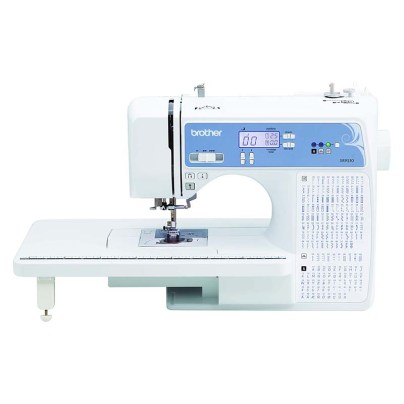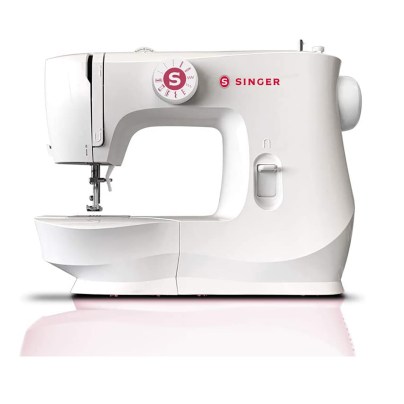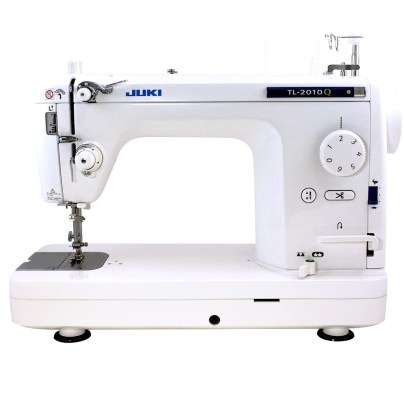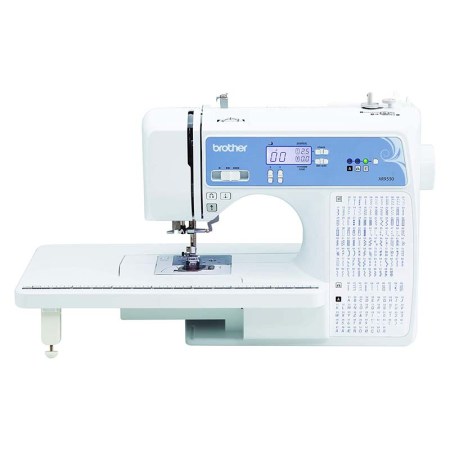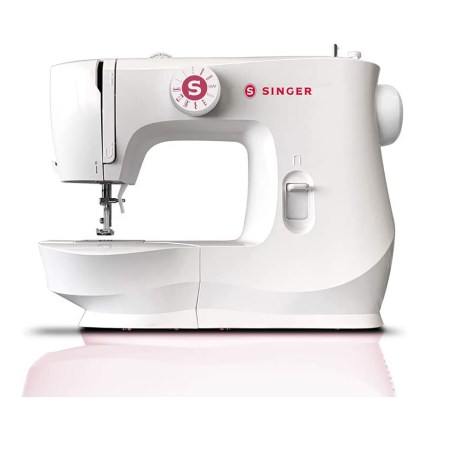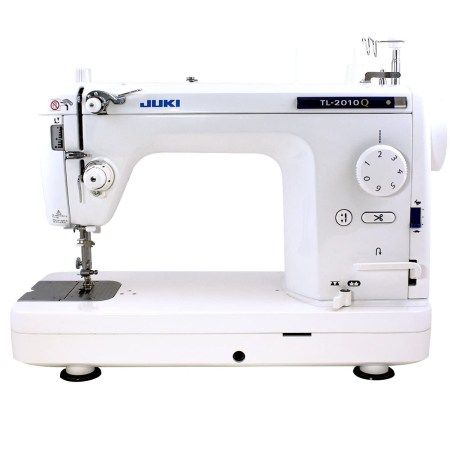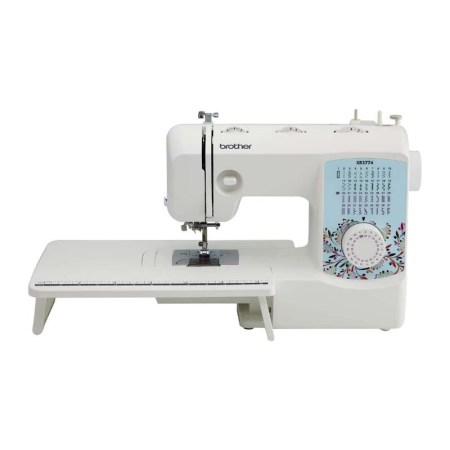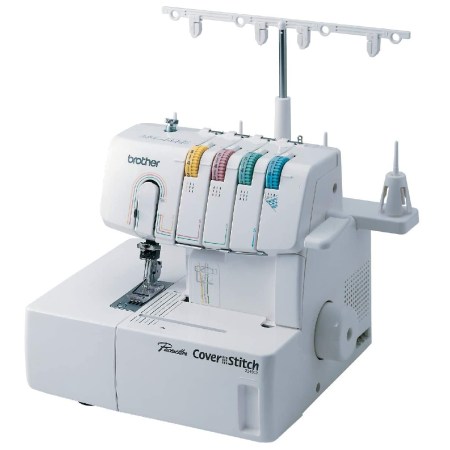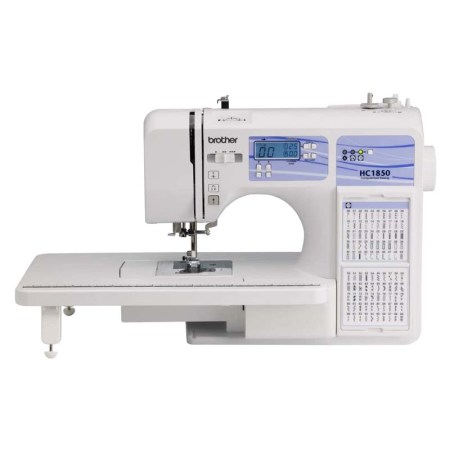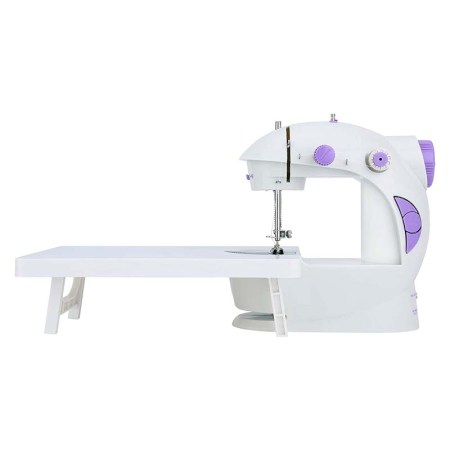We may earn revenue from the products available on this page and participate in affiliate programs. Learn More ›
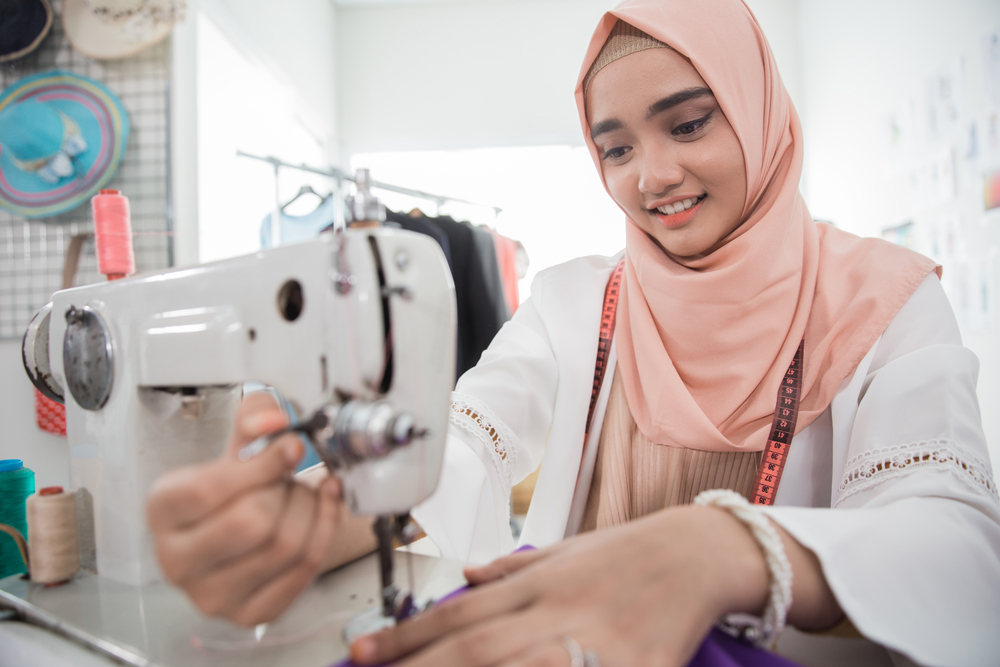
Sewing machines are great for hemming pants and curtains and making other minor alterations. With a good machine, you can repair your throw pillows, mend the seams on a tent, even stitch that rip in your grill cover. But, that’s hardly all. Owning your own sewing machine can open the door to a world of creative projects.
To a beginner, sewing machines might seem complicated. But they’re actually pretty simple. All sewing machines have a motor, a pulley system to move the needle and thread, and a paddle to operate it. However, when it comes to “extra” features, such as decorative stitch options, embroidery capabilities, and the ability to sew through heavy fabrics, the choices available can be overwhelming. This guide will help you choose the best sewing machine, whether you’re a newbie or a professional.
- BEST OVERALL: Brother Sewing and Quilting Machine, XR9550
- BEST BANG FOR YOUR BUCK: SINGER Mechanical MX60 Sewing Machine
- BEST HEAVY DUTY: Juki TL-2010Q Portable Sewing Machine
- BEST FOR QUILTING: Brother Sewing and Quilting Machine, XR3774
- BEST SERGER: Brother 2340CV Coverstitch Serger
- BEST COMPUTERIZED: Brother HC1850 Sewing and Quilting Machine
- BEST FOR KIDS: Varmax Mini Sewing Machine with Extension Table
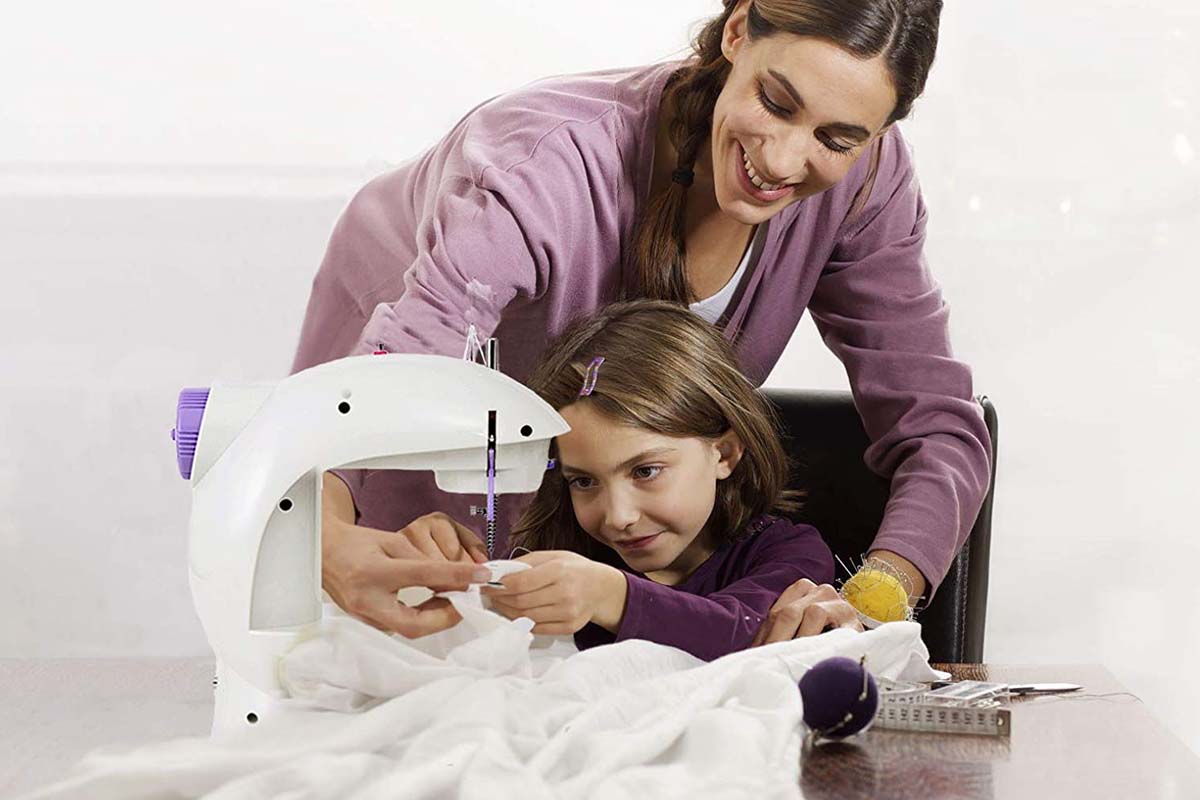
What to Consider When Choosing the Best Sewing Machine
There are a few things to consider when purchasing a sewing machine. Although all machines will create a sturdy stitch, whether you need extra features depends on your skill level, sewing requirements, and budget. As you deliberate on the best sewing machine for you, consider these factors, and also think about how you might use the machine as your sewing skills improve.
Type
There are three types of sewing machines: computerized, electric, and mechanical. True mechanical machines are not as readily available anymore, but they still are around, and some sewers love to use them with a nod to nostalgia. Each type of machine has its advantages and disadvantages.
Computerized machines come with a variety of built-in stitch types—some elaborate and others simple and all available at the touch of a button. These machines take a lot of the guesswork out of sewing, which might be especially important for beginners. The downside of computerized sewing machines is that sometimes problems can arise from software issues. This means maintenance and repairs can be more expensive than they would be for a mechanical machine.
On an electric machine, you adjust settings and stitches with a mechanical knob, but an electric motor drives the needle assembly and other components of the machine. They are a hybrid of mechanical and computerized sewing machines. These basic machines offer essential stitches for sewing projects, such as straight stitches of varying lengths and zigzag stitches of varying widths. These pared-down offerings, however, often don’t include decorative embroidery stitches. While the options are simpler, maintenance and repair are often simpler (and cheaper), too.
Mechanical sewing machines provide basic functions. These machines use a wheel that must be turned by hand or a foot pedal that must be pumped up and down to move the needle. These machines are slow but easy to operate. The foot-powered machines are sometimes called treadle sewing machines and are the type your great-grandmother might have had. Today, most people purchase these machines for novelty décor.
Size and Weight
Sewing machines come in various sizes and weights. So, it’s important to take into consideration the size of your workspace and whether you’ll be moving the machine around a lot. Do you have a dedicated sewing table, or will the machine need to be pulled out for use and then stored when you’re finished?
Machines with expandable arms to accommodate quilting are bulkier and large and are not as portable. Most beginner machines are lightweight and are easily moved and stored.
Material
Sewing machines have either plastic or metal bodies. Plastic-body machines are less expensive and lighter. Most sewing machines designed for hobby and home use have plastic bodies. They are cheaper to produce, which makes them more affordable. They also come in a wider range of sizes and are lighter to transport, making them easier to move from storage to tabletop.
Metal machines are extremely durable but cost significantly more and are heavier. Metal machines are typically made for industrial sewing purposes and can sew through tough materials such as denim, canvas, and leather. You will often find metal sewing machines in garment factories and alteration/tailoring shops.
Skill Level
Sewing machines designed for home sewing are relatively easy to use. However, the features you want in your sewing machine will depend on your skill level. Determine what type of sewing projects you want to try. Do you want to sew pillowcases, home furnishings, apparel, and accessories? Or do you plan to try quilting and embroidering? Typically, basic electrical sewing machines will accommodate most home sewing projects. Quilting and embroidery projects require machines with more stitch options and extended sewing arms for larger pieces of fabric.
The more options you have on your sewing machine, the more complicated it can be to operate, especially if you are a beginner. Experienced sewers may have fewer issues navigating computerized machines and troubleshooting common sewing problems due to skills acquired from experience. A novice sewer may be better off using a basic electric sewing machine with only a handful of options and learning how to fix common machine issues without the help of an onboard computer.
Stitching
All sewing machines provide a basic straight stitch. However, when deciding on a sewing machine, it’s important to consider the number, types, length, and width of the stitches the machine is capable of making. Some sewing projects require the ability to choose and adjust stitches.
Most models of sewing machines allow the adjustment of widths and lengths of the stitches. Some lower-priced models or kids’ machines may not have this feature, but if you are looking for a machine with versatility, pick a sewing machine that offers this possibility. Keep in mind, however, that although it may seem like a great idea to have over 100 stitch-style options, in reality, you will probably use only a handful of stitches for most sewing projects.
Here are some useful/popular stitches that will take care of most of your sewing needs:
- The straight stitch is what you will use for most of your sewing. The length of this stitch type is usually adjustable from 0 to 5 millimeters.
- The zigzag stitch is a back-and-forth one that is used for adding a finished/reinforced edge on hems or seams. This stitch is also good for use on stretchy fabrics.
- The buttonhole stitch is basically another type of zigzag stitch. It’s a programmed stitch that will create a regular border automatically with the help of a specialty buttonhole presser foot.
- The stretch/knit stitches are for sewing with knits and other types of stretchy fabrics. These stitches allow the fabric to stretch once they are sewed.
- The blind hemstitch produces almost hidden hems on pants and skirts with the help of a blind-hem presser foot.
Attachments and Presser Feet
A presser foot is an attachment that holds the fabric flat as it is fed across the stitch plate and stitched. It keeps the fabric flat so that it does not rise and fall with the needle and pucker as it is stitched. There are numerous types of presser feet that are made to work with different types of fabrics, stitches, seams, and more. The following are the most common types of presser feet that come with most machines, along with their functions.
- The all-purpose foot is used for any type of sewing, but it’s most often used in straight single-needle machines.
- An open-toe foot has a large open area in the front of the foot that provides a wide view for decorative stitching. It also gives the needle a wider area to move in various directions when creating the decorative stitching.
- The zipper foot is narrow, which allows for close stitching around a zipper.
- A buttonhole foot is rectangular and helps you sew neat and uniform buttonholes. They are often used in conjunction with the programmed buttonhole stitch on computerized machines.
- The blind-stitch hem foot features an extension at the front of the foot for guiding the fabric fold. The foot is used in conjunction with the blind hemstitch.
There are also many other types of specially designed presser feet for quilting and embroidery. Standard machines normally do not come with these specialty presser feet, and they are often purchased separately.
Other accessories available for sewing machines include dust covers, magnetic sewing guides, needles, and bobbins.
Needle Features
The needle punctures through the fabric, drawing the thread with it and creating stitches. All machines feature a shank that holds the needle and the presser foot. However, there are a few features that will make it easier for you to sew.
A machine with a needle up/down feature allows you to hold the needle in either the up or down position. This feature is useful for rotating and turning fabric when sewing. Another useful feature is a machine that allows you to adjust the needle to the left or right, instead of remaining dead center. This is useful when sewing on zippers with a zipper foot. And a machine with an automatic needle threader takes the guesswork and frustration out of threading a needle.
Most machines come with a package of universal needles that will handle the widest range of sewing applications. However, needles are designed for specific types of fabric. Be sure to choose the correct type of needle based on what you are sewing.
Additional Features
With the exception of stitch options, additional features such as an LED display and built-in work lights are what makes one machine stand out from another. Here are some common features to look for in a sewing machine that can make sewing so much easier:
- An automatic thread cutter minimizes the need to keep a pair of scissors near your machine.
- An adjustable speed control feature lets you customize how fast or slow you stitch, which is good for beginners.
- Machines with LED panel controls make it easier and faster to select the right stitch and adjust the stitch setting and thread tension.
- Built-in work lights illuminate your work area while sewing.
- Adjustable feed dogs are a must for free-motion quilters. Feed dogs are metal, teeth-like ridges underneath the throat plate of a sewing machine. They gently grip the fabric to help it pass through the sewing machine as the needle creates the stitch. This feature allows you to lower the feed dogs to create a smooth sewing surface. Some machines come with a simple plate to place over the feed dogs in order to perform darning or free-motion quilting tasks on the machine.
- A free arm is a slimmer part of the sewing machine that remains when you slide off the larger detachable base. The free arm allows you to sew narrow “tubes” of fabric such as sleeves or pant legs.
Cleaning and Maintenance
Cleaning and maintenance are an integral part of keeping your sewing machine in top working condition. Although it’s recommended that you have your machine professionally serviced once a year for average use, there are tasks you can perform after each use.
Sewing machines need frequent dusting to avoid jammed thread or components. Compressed air can help remove lint and thread from feed dogs, tension discs, and the bobbin area. Sewing machines have many internal moving parts and can benefit from regular oiling to help these parts run smoother and for longer. Only use oil designed specifically for use with sewing machines.
When the machine is not in use, keep it covered. This will keep excess dust off your machine and make sure it’s clean and ready to go when you are ready to sew.
Our Top Picks
Below are some of the top sewing machine picks for beginners and a few others for the stitcher who’s ready to up their game. The picks are based on ease of use, durability, and price.
Best Overall
Brother Sewing and Quilting Machine, XR9550
See ItBrother is well known for easy-to-use and economical home-crafting machines. This is our top pick because it’s a great option for beginner and experienced seamsters alike.
The XR9550 makes it easy to add decorative stitches to your project. Decorative options are just a few among the 165 built-in stitches that also include utility, heirloom, and quilting stitches as well as seven one-step, auto-size buttonholes. The stitches are preprogrammed and easy to read on the LCD display.
New seamsters can create embroidery stitches and adjust thread tension with the touch of a button. Seasoned sewers have plenty of stitch options and accessories to complete quilt projects without a dedicated quilting machine. The larger detachable table is great for quilting, too.
The XR9550 will even thread your needle for you. The automatic needle threader and quick-set bobbin system will have you threaded up and sewing in seconds. This machine also includes eight sewing feet, a quilt guide, and a protective hard case.
The only real disadvantage of the Brother XR9550 is that it’s a fully computerized machine. If it stops working due to a software malfunction, it can be expensive to repair.
Best Bang For Your Buck
SINGER Mechanical MX60 Sewing Machine
See ItThe Singer MX60 is a mechanical machine. That means you’ll turn a knob to switch between the six different stitches. The length and width of the stitches are preset. So, that’s one less decision you’ll have to make.
This machine is designed to take care of light sewing tasks such as hemming, patching holes, and creating buttonholes. It comes with basic accessories to get you started, including a general-purpose presser foot, a zipper foot, a buttonhole foot, a darning plate, needles, and bobbins. The Singer MX60 is a solid machine for simple sewing needs and is a great choice for hobbyists and beginners.
Manual machines have one significant advantage over computerized ones: they are easier to repair. Since they don’t have any computerized components, the solution to most malfunctions is a minor adjustment.
Best Heavy Duty
Juki TL-2010Q Portable Sewing Machine
See ItJuki machines are standard in industrial sewing because they are so tough. The smaller home machines are built with the same quality.
This is a mechanical machine, so it doesn’t offer decorative stitches. But it has some other important features. The intuitive sub-tension system helps maintain the correct thread tension while you sew. The even-feed foot ensures difficult-to-feed fabrics run through the machine smoothly.
The Juki TL-2010Q also has LED lighting and a large work area of up to 23 inches with the attached auxiliary table.
The TL-2010Q can handle quilt, apparel, and home décor projects. This machine is well suited to free-motion quilters or those who run a small sewing business but are not ready to upgrade to a full industrial machine.
Best For Quilting
Brother Sewing and Quilting Machine, XR3774
See ItQuilters need a machine that gives them enough space to move large, heavy, layered fabrics with ease. The Brother XR3774 delivers. It’s a mechanical sewing machine designed with must-have quilting features that both new and experienced quilters will appreciate.
The sewing machine comes with an oversize table that makes it easy to maneuver larger quilting projects. The included specialty sewing feet should meet most of your quilting needs. The included walking foot allows for smooth feeding of multiple layers. The spring-action quilting foot can accommodate varying fabric heights. The clear plastic foot lets you see what you’re doing while you sew. Plus, there are 37 built-in stitches, including decorative stitches that will make your project look professional.
This machine is not just for quilters, though. Makers can sew apparel, create home décor, and complete basic repairs with this one. The Brother XR3774 is an affordable yet feature-packed machine that will take care of most of your sewing needs.
Best Serger
Brother 2340CV Coverstitch Serger
See ItA serger is a specialized machine that trims fabric edges and encloses those edges inside a thread casing. You can find serger stitches along the hem and the inside seams of a T-shirt, for example. Sergers use multiple threads to create strong, durable stitches that won’t fray and will last for years. The Brother 2340CV coverstitch serger features multiple functions that are great for working with stretch fabrics and creating necklines and hems.
Sergers can be intimidating to thread, but the Brother 2340CV’s color-coded system is easy to follow. This machine also features adjustment dials for stitch length, a presser foot dial, snap-on feet, and a differential feed, which allows you to alter the speed at which your fabric feeds through the machine.
For most home sewers, sergers are optional. There are other ways to create a professional-looking seam, but those methods take longer and involve multiple steps, whereas sergers finish seams fast. This is a good pick for the home sewer who wants to add a professional finish to sewing projects.
Best Computerized
Brother HC1850 Sewing and Quilting Machine
See ItThe Brother HC1850 is good for both new and experienced sewers. This computerized sewing machine is easy to operate and offers advanced features that experienced sewers will appreciate, too.
The Brother HC1850 has plenty of computerized functions to help make sewing easy. It has 185 built-in sewing and quilting stitches including utility, decorative, and buttonhole stitches. It also features a wide table, eight presser feet, and an easy-to-use LCD screen that allows you to select stitches and make adjustments with the touch of a button.
The computerized Brother HC1850 offers a lot of options whether you are looking for your first machine or an upgrade from a mechanical model.
Best for Kids
Varmax Mini Sewing Machine with Extension Table
See ItThis beginner machine features the basics needed to get started with machine sewing. It’s a mechanical machine with a few options that will not overwhelm beginners. You can even teach your children to sew on the Varmax mini sewing machine.
The Varmax is a basic machine that will make a simple running stitch and teach beginners how to thread a machine, fill a bobbin, and perform basic sewing operations. It has a built-in lamp, thread cutter, and cuff slot. It also features an extension table, which makes the sewing machine more stable and provides extra workspace.
Keep in mind: This is a small machine and not suited for larger projects. But it’s not just for kids! The Varmax mini sewing machine is a great option for small spaces or to keep as a backup machine.
Safety Tips for Using a Sewing Machine
Although machine sewing is a relatively safe hobby, it still uses a machine with moving parts. Like any machine that’s powered by electricity, there are some things to keep in mind when operating and performing maintenance on the machine. Following these safety tips will keep you safe and make your machine perform better.
- Inspect the power cord for any frays or exposed wires.
- Turn off the machine and unplug when you’re performing any type of maintenance or when it’s not in use.
- Watch your fingers! Always pay attention to the placement of your fingers when sewing.
- Check for broken needles before you start sewing. Broken needles can damage your fabric and potentially the machine.
- Don’t sew over pins. Remove the pins as you sew. Sewing over pins can break or bend the pins (making them difficult to remove), damage your fabric, break your needle, or cause the pins to become mini projectiles.
- Pay attention to any unusual sounds. If the sewing machine starts making strange noises or seems louder than usual, it may be time to take it in for an inspection by a professional.
- Get it serviced. A sewing machine needs professional servicing at least once a year (depending on use).
FAQs About Your New Sewing Machine
Sewing machines can seem intimidating to beginners, but once you know how they operate, they are safe and easy to use. Here are some common questions about sewing machines.
Q. Are sewing machines dangerous?
Like any machine, a sewing machine can be dangerous if not used correctly. Always follow the safety guidelines provided by the manufacturer when it comes to maintenance, and pay attention while sewing.
Q. What are features to look for in a sewing machine?
The best features will depend on the type of sewing you plan to do. For a beginner, some features to look for include built-in stitch types, an automatic needle threader, a top drop-in bobbin, and a set of standard presser feet.
Q. Do you need a special sewing machine for leather?
No, although a heavy-duty machine will make it easier. However, any good-quality home sewing machine can handle leather with a few special accessories. You will need a Teflon presser foot, a needle designed for sewing leather, and heavy-duty thread.
Q. Can a regular sewing machine sew vinyl?
Yes, with the same modifications listed above for leather.
Q. Can a normal sewing machine sew canvas?
Yes, canvas can be sewn on a regular sewing machine.
